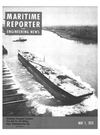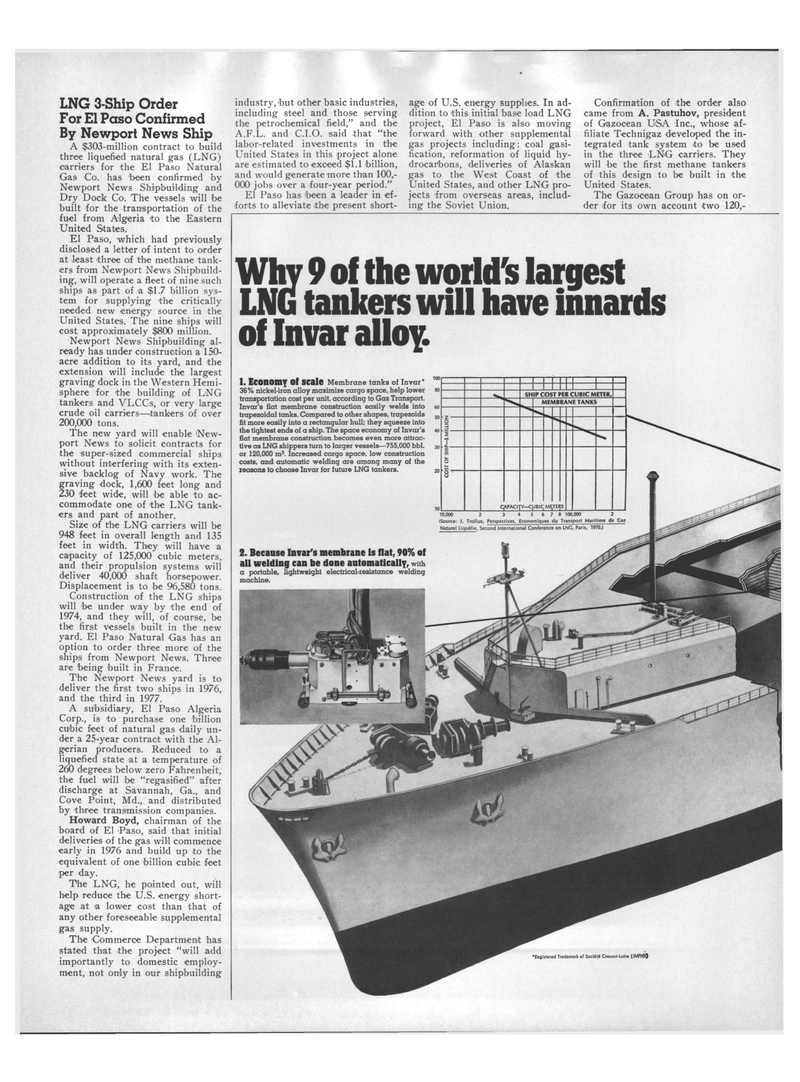
Page 8: of Maritime Reporter Magazine (May 1973)
Read this page in Pdf, Flash or Html5 edition of May 1973 Maritime Reporter Magazine
LNG 3-Ship Order
For El Paso Confirmed
By Newport News Ship
A $303-million contract to build three liquefied natural gas (LNG) carriers for the El Paso Natural
Gas Co. has 'been confirmed by
Newport News Shipbuilding and
Dry Dock Co. The vessels will 'be built for the transportation of the fuel from Algeria to the Eastern
United States.
El Paso, which had previously disclosed a letter of intent to order at least 'three of the methane tank- ers from Newport News Shipbuild- ing, will operate a fleet of nine such ships as part of a $1.7 billion sys- tem for supplying the critically needed new energy source in the
United States. The nine ships will cost approximately $800 million.
Newport News Shipbuilding al- ready has under construction a 150- acre addition to its yard, and the extension will include the largest graving dock in the Western Hemi- sphere for the building of LNG tankers and VLCCs, or very large crude oil carriers—.tankers of over 200,000 tons.
The new yard will enable New- port News to solicit contracts for the super-sized commercial ships without interfering with its exten- sive backlog of Navy work. The graving dock, 1,600 feet long and 230 feet wide, will 'be able to ac- commodate one of the LNG tank- ers and part of another.
Size of the LNG carriers will be 948 feet in overall length and 135 feet in width. They will have a capacity of 125,000 cubic meters, and their propulsion systems will deliver 40,000 shaft horsepower.
Displacement is to be 96,580 tons.
Construction of the LNG ships will be under way by the end of 1974, and they will, of course, be the first vessels built in the new yard. El Paso Natural Gas has an option to order three more of the ships from Newport News. Three are being built in France.
The Newport News yard is to deliver the first two ships in 1976, and the third in 1977.
A subsidiary, El Paso Algeria
Corp., is to purchase one billion cubic feet of natural gas daily un- der a 25-year contract with the Al- gerian producers. Reduced to a liquefied state at a temperature of 260 degrees below zero Fahrenheit, the fuel will be "regasified" after discharge at Savannah, Ga., and
Cove Point, Md., and distributed by three transmission companies.
Howard Boyd, chairman of the board of El 'Paso, said that initial deliveries of the gas will commence early in 1976 and build up to the equivalent of one billion cubic feet per day.
The LNG, he pointed out, will help reduce the U.S. energy short- age at a lower cost than that of any other foreseeable supplemental gas supply.
The Commerce Department has stated that the project "will add importantly to domestic employ- ment, not only in our shipbuilding industry, but other basic industries, including steel and those serving the petrochemical field," and the
A.F.L. and C.I.O. said that "the labor-related investments in the
United States in this project alone are estimated to exceed $1.1 billion, and would generate more than 100,- 000 jobs over a four-year period."
El Paso has 'been a leader in ef- forts to alleviate the present short- age of U.S. energy supplies. In ad- dition to this initial base load LNG project, El Paso is also moving forward with other supplemental gas projects including: coal gasi- fication, reformation of liquid hy- drocarbons, deliveries of Alaskan gas to the West Coast of the
United States, and other LNG pro- jects from overseas areas, includ- ing the Soviet Union.
Confirmation of the order also came from A. Pastuhov, president of Gazocean USA Inc., whose af- filiate Technigaz developed the in- tegrated tank system to be used in the three LNG carriers. They will be the first methane tankers of this design to be built in the
United States.
The Gazocean Group has on or- der for its own account two 120,-
Why 9 of the world's largest
LNG tankers will have innards of Invar alloy. •Registered Trademark of Social* CreuioMoire tIMFHY) {Source: ). Trollux, Perspectives. Economiques du Transport Maritime dc Ga*
Nature! Liqu^fie, Second International Conference on LNG, Paris, 1970.) 1. Economy of scale Membrane tanks of Invar* 36% nickel-iron alloy maximize cargo space, help lower transportation cost per unit, according to Gaz Transport.
Invar's flat membrane construction easily welds into trapezoidal tanks. Compared to other shapes, trapezoids fit more easily into a rectangular hull; they squeeze into the tightest ends of a ship. The space economy of Invar's flat membrane construction becomes even more attrac- tive as LNG shippers turn to larger vessels—755,000 bbl. or 120,000 m3. Increased cargo space, low construction costs, and automatic welding are among many of the reasons to choose Invar for future LNG tankers. 2. Because Invar's membrane is flat, 90% of all welding can be done automatically, with a portable, lightweight electrical-resistance welding machine. 60 50 40 30 20

 7
7

 9
9
